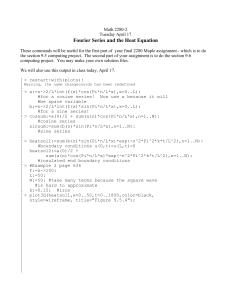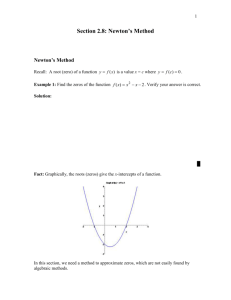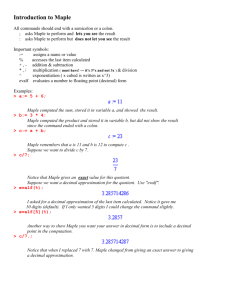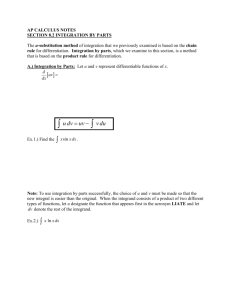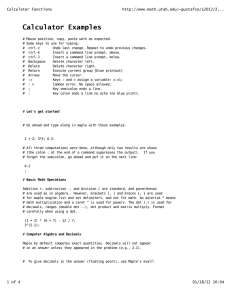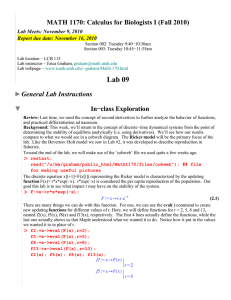The sine integral. (This is featured in problem 92 on... f:=x->int(sin(t)/t,t=0..x); f := proc (x) options operator, arrow; int(sin(t)/t, t =...
advertisement
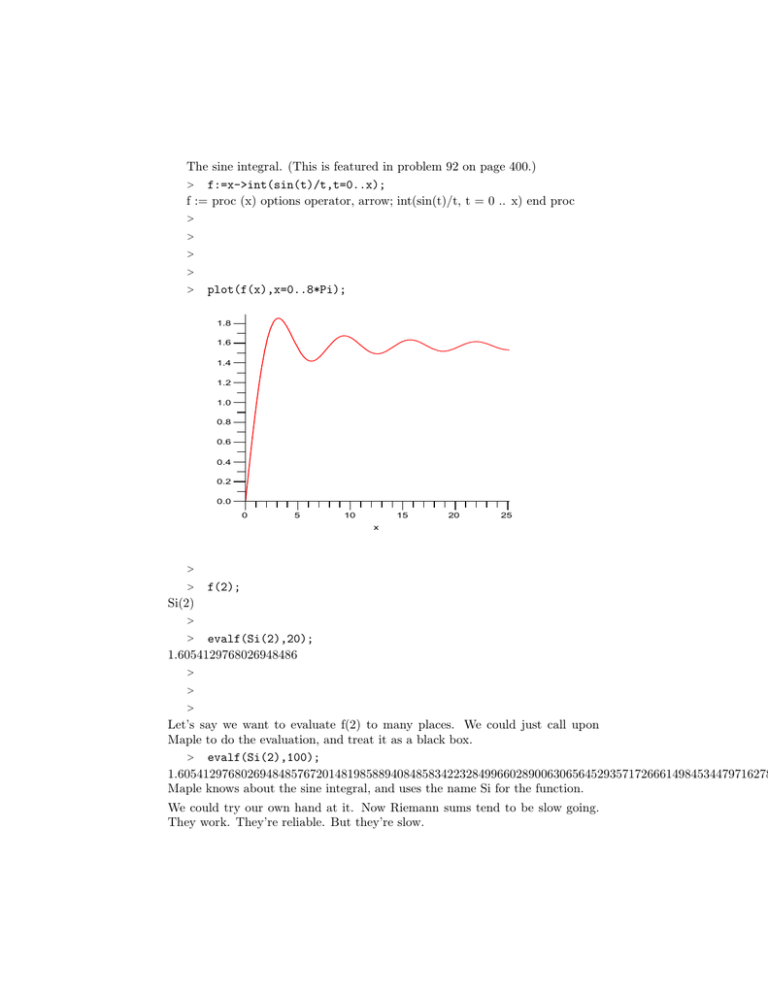
The sine integral. (This is featured in problem 92 on page 400.) > f:=x->int(sin(t)/t,t=0..x); f := proc (x) options operator, arrow; int(sin(t)/t, t = 0 .. x) end proc > > > > > plot(f(x),x=0..8*Pi); 1.8 1.6 1.4 1.2 1.0 0.8 0.6 0.4 0.2 0.0 0 5 10 15 20 25 x > > f(2); Si(2) > evalf(Si(2),20); 1.6054129768026948486 > > > > Let’s say we want to evaluate f(2) to many places. We could just call upon Maple to do the evaluation, and treat it as a black box. > evalf(Si(2),100); 1.60541297680269484857672014819858894084858342232849966028900630656452935717266614984534479716278 Maple knows about the sine integral, and uses the name Si for the function. We could try our own hand at it. Now Riemann sums tend to be slow going. They work. They’re reliable. But they’re slow. > n:=100;riemannsum:=(1/n)*sum(evalf(sin(j/n)/(j/n)),j=1..200); n := 100riemannsum := 1.602682595 We could average the Riemann sums got by starting at the left, with that got by starting at the right. Happily, to do that, we need only add half the difference between the last term and what would have been the first, 1/200, in the previous calculation. This would give us a nice bump in accuracy for almost no extra computational work. > riemannsum+(1/200)*(1-sin(2)/2); 1.607682595-1/400*sin(2) > > evalf(%); 1.605409351 We could use the series expansion for sin(x), the one we got in class on Wednesday by running the fact that cos(x) ≤ 1 for all x through the logic mill based Rf Rx on the fact that if f ≤ g on the interval [0, x], then 0 f (t) dt ≤ 0 g(t) dt. R R ˆd ≤ ˆ d. > sin(x)=x-x^3/3!+x^5/5!-x^7/7!...=sum((-1)^k*x^(2*k+1)/(2*k+1)!,k=0..infinity); > Of course, we cannot actually do infinitely many terms. We shall have to quit after some number of terms. Now as we showed in class, the actual value rests between the value got by quitting after n terms, and that got by quitting instead after n+1 terms. When the next term, the first one we don’t use, is small enough, we know we have an answer that’s good enough. The same goes for the sine integral, since the actually integrand lies always between the integrand we’d get by using n terms, and the one we’d get by using n+1. So, here goes, with twenty terms. We use the fact that R (+) (/) · (+) / (+)! d = ((+)!·(+)) . Here, x=2 because we’re evaluating Si(2). > > a:=2;for k from 1 to 20 do a:=a+(-1)^k*2^(2*k+1)/((2*k+1)!*(2*k+1)) od:a; 218403664163421157775530071933187868316598450550122 a := 11463507788552631660702214986713028771039193359375 1.605412976802694848576720148198588940849 > The next term, the one we didn’t use, is k=21st, and would have given 2ˆ(43)/(43!*43) > evalf(-2^(43)/(43!*43)); -0.3385904364e-41 That’s an error of about 3 times 10ˆ(-42). This shows that taking the first 20 terms was good enough to get us 40 places. With today’s machinery, it is no problem at all to take 20 terms, or even 200. > a:=2;for k from 1 to 200 do a:=a+(-1)^k*2^(2*k+1)/((2*k+1)!*(2*k+1)) od: And then evaluate to 400 digits: 1.605412976802694848576720148198588940848583422328499660289 0063065645293571726661498453447971627870316075803471736861 4476201562988431297575288851361155757431044488496317431853 0108686914748783734213526817328039824444296114374596608926 2822146534889028881507409886241022959756191888130873888741 6084278347252143346596408991452089501980571560839985097687 0742032789740255942070910412702856362882408542593566 > evalf(Si(2),400); 1.60541297680269484857672014819858894 I suppressed the rest of the Maple result because it would just have gone off the end of the page. But it agreed, all the way out. We didn’t really need to know the value of this integral to 4 places, much less 400. On the other hand, this tends to drive home the point that these series methods are really powerful, and permit us to say, in many cases, that our approximate answers are so good that they may as well be exact. > > >

